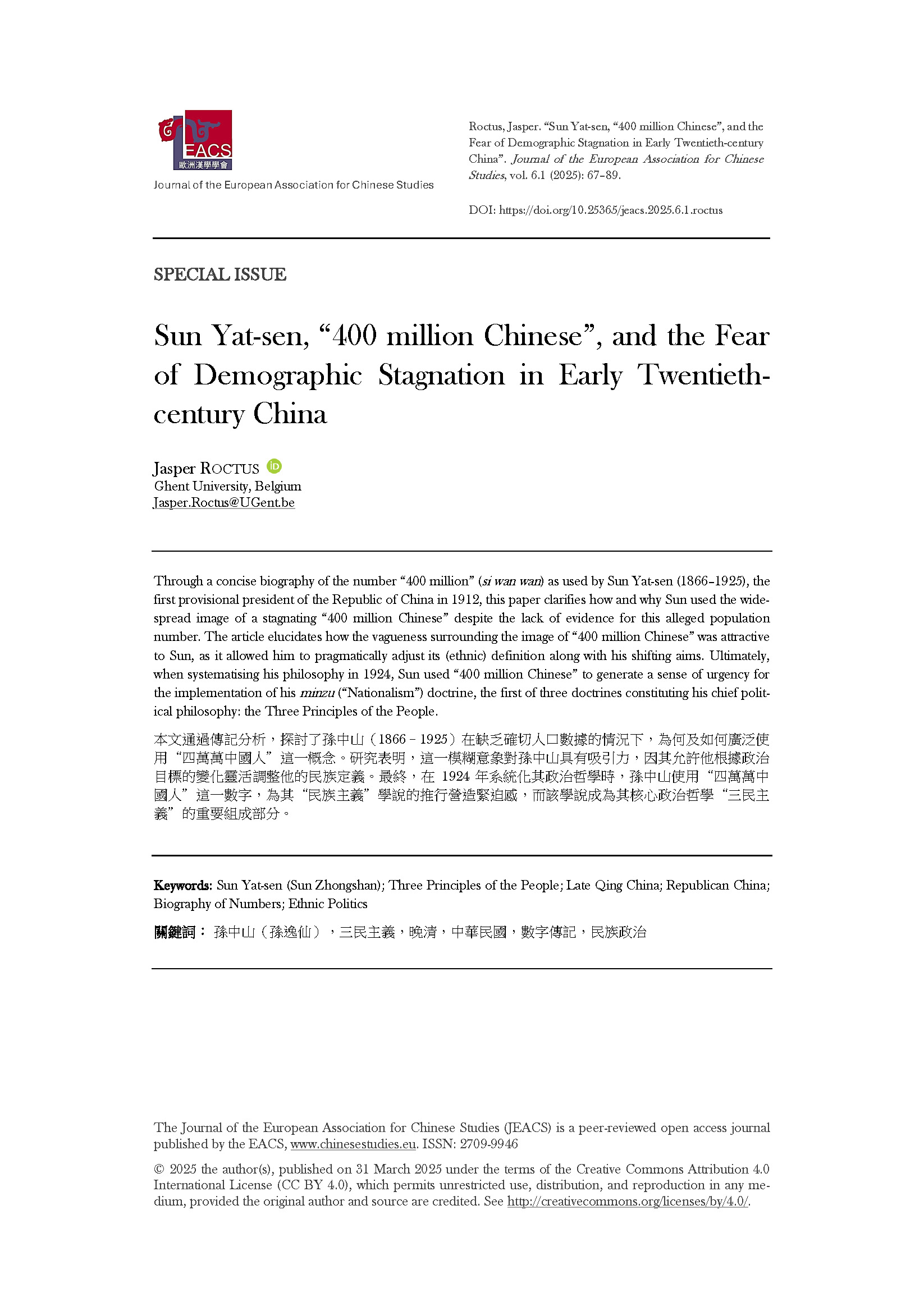Sun Yat-sen, “400 million Chinese”, and the Fear of Demographic Stagnation in Early Twentieth-century China
DOI:
https://doi.org/10.25365/jeacs.2025.6.1.roctusKeywords:
Sun Yat-sen (Sun Zhongshan); Three Principles of the People; Late Qing China; Republican China; Biog-raphy of Numbers; Ethnic PoliticsAbstract
Through a concise biography of the number “400 million” (si wan wan) as used by Sun Yat-sen (1866–1925), the first provisional president of the Republic of China in 1912, this paper clarifies how and why Sun used the widespread image of a stagnating “400 million Chinese” despite the lack of evidence for this alleged population number. The article elucidates how the vagueness surrounding the image of “400 million Chinese” was attractive to Sun, as it allowed him to pragmatically adjust its (ethnic) definition along with his shifting aims. Ultimately, when systematising his philosophy in 1924, Sun used “400 million Chinese” to generate a sense of urgency for the implementation of his minzu (“Nationalism”) doctrine, the first of three doctrines constituting his chief political philosophy: the Three Principles of the People.
本文通過傳記分析,探討了孫中山(1866–1925)在缺乏確切人口數據的情況下,為何及如何廣泛使用“四萬萬中國人”這一概念。研究表明,這一模糊意象對孫中山具有吸引力,因其允許他根據政治目標的變化靈活調整他的民族定義。最終,在1924年系統化其政治哲學時,孫中山使用“四萬萬中國人”這一數字,為其“民族主義”學說的推行營造緊迫感,而該學說成為其核心政治哲學“三民主義”的重要組成部分。
Downloads
References
Anderson, Patrick. 2016. The Lost Book of Sun Yatsen and Edwin Collins. Abingdon: Routledge.
Bergère, Marie-Claire. 1998. Sun Yat-sen. Translated by Janet Lloyd. Stanford: Stanford University Press.
Bréard, Andrea. 2019. “400 Millionen: Globale Wirkungen Einer Mächtigen Zahl” (400 Million: the Global Effects of a Powerful Number). In N. Bilo, S. Haas and M.C. Schnei-der, eds., Kulturgeschichte der Statistik (Cultural History of Statistics), 215–232. Stuttgart: Steiner Verlag.
Cantlie, James, and Charles S. Jones. 1912. Sun Yat-sen and the Awakening of China. New York: Fleming H. Revell Company.
Chang Hsu-Hsin and Leonard H.D. Gordon. 1991. All Under Heaven: Sun Yat-sen and His Revolutionary Thought. Stanford: Hoover Institution Press.
Durand, John D. 1960. “The Population Statistics of China, A.D. 2–1953”. Population Stud-ies 13/3: 209–256.
George, Henry. (1879) 1912. Progress and Poverty: an Inquiry into the Cause of Industrial Depressions and of Increase of Want with Increase of Wealth, the Remedy. Fourth Edi-tion. Garden City: Doubleday, Page, & Co.
Ho Ping-ti. 1959. Studies on the Population of China, 1368–1953. Cambridge: Harvard Uni-versity Press.
Hu Shengwu 胡绳武 and Dai Angang 戴鞍钢. 1996. “Shi lun Sun Zhongshan de renkou sixiang” 试论孙中山的人口思想 (Tentative Discussion of Sun Yat-sen’s Population Thought). Xueshu yanjiu 10: 16–20.
Jansen, Marius B. 1967. The Japanese and Sun Yat-sen. Stanford: Stanford University Press.
Lenin, Vladimir. 1977. V.I. Lenin Collected Works, Volumes 1–45 (Complete). Fourth edi-tion. Moscow: Progress Publishers.
Li Daoji 李道缉. 2009. “Sun Zhongshan renkou sixiang chuyi” 孙中山人口思想刍议 (Viewpoint on Sun Yat-sen’s Population Thought). Jindai Zhongguo 19: 63–77.
Miyazaki Tōten. (1902) 1982. My Thirty-three Years’ Dream: the Autobiography of Miya-zaki Tōten. Translated by Eto Shinkichi and Marius B. Jansen. Princeton: Princeton Uni-versity Press.
Murata Yūjirо̄ 村田雄二郎. 2004. “Sun Zhongshan yu Xinhai geming shiqi de ‘Wuzu gonghe’ lun” 孙中山与辛亥革命时期的“五族共和”论 (Sun Yat-sen and the “Republic of the Five Nationalities” during the Revolution of 1911). Guangdong shehui kexue 5: 121–128.
Porter, Theodore. (1995) 2020. Trust in Numbers: the Pursuit of Objectivity in Science and Public Life. Princeton: Princeton University Press.
Pusey, James R. 1983. China and Charles Darwin. Cambridge: Harvard University Press.
Schiffrin, Harold Z. 1980. Sun Yat-sen: Reluctant Revolutionary. Boston: Little, Brown.
Spence, Jonathan D. 2012. The Search for Modern China. Third edition. New York: W.W. Norton.
Sun Yat-sen. 1897. Kidnapped in London. London: Simpkin, Marshall, Hamilton, Kent and Company Limited.
———. (1920) 1941. The International Development of China. Second edition. Chongqing and Hong Kong: The China Publishing Company.
———. 1989. Guofu quanji 國父全集 (The Complete Works of the Father of the Republic). Taipei: Jindai Zhongguo chuban zhongyang wenwu jingxiao. https://sunology.culture.tw/
Tong Lam. 2011. A Passion for Facts: Social Surveys and the Construction of the Chinese Nation-state, 1900–1949. Berkeley, Los Angeles and London: University of California Press.
Twitchett, Denis, Michael Loewe, and John K. Fairbank, 1986. Cambridge History of China: the Ch'in and Han Empires 221 B.C.–A.D. 220. Cambridge: Cambridge University Press.
Yan Deru 颜德如. 2016. “Qingmo Minchu Zhongguo renkou ‘si wan wan’ shuo zhi kaocha: yi Sun Zhongshan wei zhongxin” 清末民初中国人口“四万万”说之考察:以孙中山为中心 (An Investigation into the Theory of a Chinese Population of “400 Million” in the Late Qing and Early Republic, with a Focus on Sun Yat-sen). Fujian luntan (renwen shehui kexueban) 6: 87–90.
Wells, Audrey. 2001. The Political Thought of Sun Yat-sen: Development and Impact. Houndmills, Basingstoke and Hampshire, New York: Palgrave.
Wilbur, Clarence M. 1976. Sun Yat-sen, Frustrated Patriot. New York: Columbia University Press.
———. 1984. The Nationalist Revolution in China, 1923–1928. Cambridge: Cambridge Uni-versity Press.
Wilbur, Clarence M., and Julie Lien-ying How. 1989. Missionaries of Revolution: Soviet Ad-visers and Nationalist China, 1920–1927. Cambridge: Harvard University Press.
Wu Benxia 伍本霞. 2015. “Sun Zhongshan jinhualun sixiang zai renshi” 孙中山进化论思想再认识 (Another Look at Sun Yat-sen’s Thought on the Theory of Evolution). Xiangtan daxue xuebao (zhexue shehui kexueban) 39/1: 126–130.
Zhang Jianhua 张建华. 2002. “Shi lun Sun Zhongshan renkou sixiang zhong de yi ge beilun” 试论孙中山人口思想中的一个悖论 (A Paradox in Sun Yat-sen’s Thought on Popula-tion). Ningbo dangxiao xuebao 6: 75–77.

Downloads
Published
How to Cite
Issue
Section
License
Copyright (c) 2025 Jasper Roctus (Author)

This work is licensed under a Creative Commons Attribution 4.0 International License.
